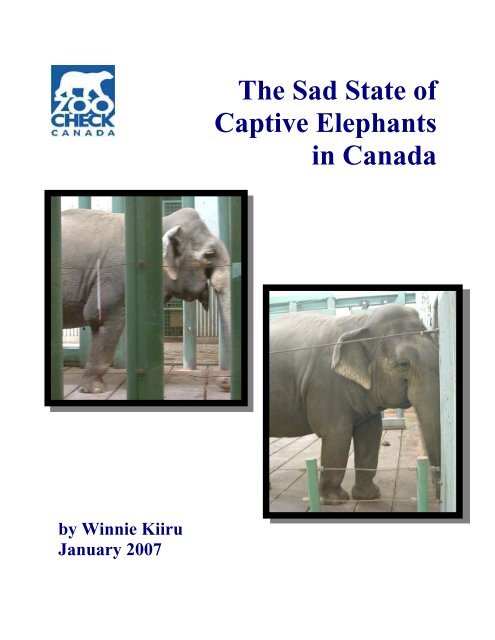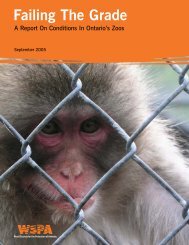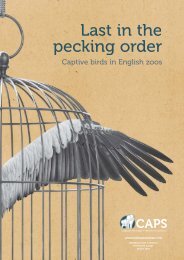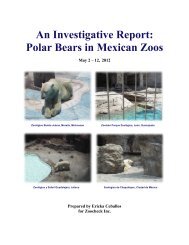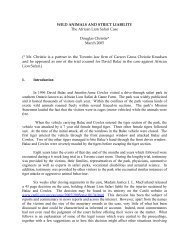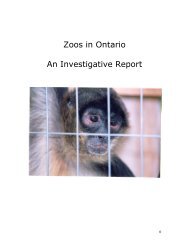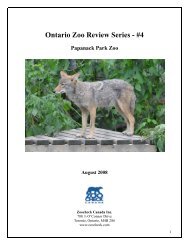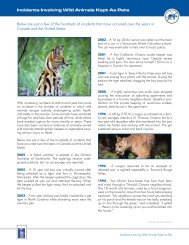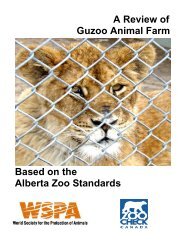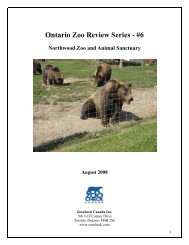The Sad State of Captive Elephants in Canada - Zoocheck Canada
The Sad State of Captive Elephants in Canada - Zoocheck Canada
The Sad State of Captive Elephants in Canada - Zoocheck Canada
Create successful ePaper yourself
Turn your PDF publications into a flip-book with our unique Google optimized e-Paper software.
y W<strong>in</strong>nie Kiiru<br />
January 2007<br />
<strong>The</strong> <strong>Sad</strong> <strong>State</strong> <strong>of</strong><br />
<strong>Captive</strong> <strong>Elephants</strong><br />
<strong>in</strong> <strong>Canada</strong>
<strong>The</strong> <strong>Sad</strong> <strong>State</strong> <strong>of</strong> <strong>Captive</strong> <strong>Elephants</strong> <strong>in</strong> <strong>Canada</strong><br />
by W<strong>in</strong>nie Kiiru<br />
About the Author 1<br />
Introduction 2 – 3<br />
<strong>Elephants</strong> <strong>in</strong> <strong>Canada</strong> 4 – 5<br />
Toronto Zoo 6 – 7<br />
Calgary Zoo 8 - 9<br />
Parc Safari 10 - 11<br />
Granby Zoo 12 - 13<br />
African Lion Safari 14 - 16<br />
Bowmanville Zoo 17 - 18<br />
Edmonton Valley Zoo 19 - 20<br />
Summary <strong>of</strong> Observations 21 - 22<br />
Recommendations 23<br />
1
ABOUT THE AUTHOR<br />
W<strong>in</strong>nie Kiiru has been work<strong>in</strong>g to protect the wildlife<br />
<strong>of</strong> Kenya for more than 15 years and currently serves<br />
as a consultant to numerous local and <strong>in</strong>ternational<br />
wildlife organizations.<br />
Most recently, Ms. Kiiru served as Project Manager<br />
for the Amboseli Human-Elephant Conflict Project<br />
where she worked with eng<strong>in</strong>eers and technicians to<br />
develop and test humane deterrents to prevent human-<br />
elephant conflict situations.<br />
From 2000 until 2004, Ms. Kiiru served as the East<br />
Africa Representative for the Born Free Foundation<br />
(BFF), an <strong>in</strong>ternational wildlife protection charity<br />
based <strong>in</strong> the United K<strong>in</strong>gdom. As the BFF<br />
representative, Kiiru represented the foundation <strong>in</strong> regional and <strong>in</strong>ternational conservation<br />
forums and <strong>in</strong> the delivery <strong>of</strong> their African field projects.<br />
Dur<strong>in</strong>g that time Ms. Kiiru also served as Regional Representative <strong>of</strong> the Species Survival<br />
Network, a coalition <strong>of</strong> 67 non-governmental wildlife protection organizations from around the<br />
world.<br />
From 1992 until 1997, W<strong>in</strong>nie Kiiru was employed by the Kenya Wildlife Service (KWS). For<br />
several years, she served as a Research Scientist for the KWS Elephant Management Program<br />
where she designed and supervised nationwide surveys <strong>of</strong> Kenya's elephant populations. She was<br />
also responsible for monitor<strong>in</strong>g human-elephant conflict throughout the country and for the<br />
development <strong>of</strong> mitigation strategies.<br />
Dur<strong>in</strong>g her last two years at the KWS, she was a Community Specialist responsible for a broad<br />
range <strong>of</strong> human-elephant conflict mitigation work across the country.<br />
Ms. Kiiru received her Bachelor <strong>of</strong> Education (Science) from the Kenyatta University <strong>in</strong> 1990<br />
and a Masters degree <strong>in</strong> Tropical Resource Ecology from the University <strong>of</strong> Zimbabwe <strong>in</strong> 1995.<br />
She is currently pursu<strong>in</strong>g her PhD <strong>in</strong> Biodiversity Management through the University <strong>of</strong> Kent.<br />
W<strong>in</strong>nie Kiiru lives <strong>in</strong> Nairobi, Kenya with her husband and two sons.<br />
2
INTRODUCTION<br />
It is now widely acknowledged that elephants are sentient be<strong>in</strong>gs, self aware, highly <strong>in</strong>telligent<br />
and with complex social networks. <strong>Elephants</strong> share these attributes with humans, apes and<br />
dolph<strong>in</strong>s. Long-term studies conducted by the Amboseli Elephant Research Project have led to<br />
greater understand<strong>in</strong>g <strong>of</strong> the complex nature <strong>of</strong> elephant social, cognitive, emotional and<br />
communicative abilities.<br />
An elephant family is comprised <strong>of</strong> a matriarch, her female <strong>of</strong>fspr<strong>in</strong>g and their young. <strong>The</strong><br />
matriarch leads the family group through a range <strong>of</strong> daily, seasonal and lifetime events <strong>in</strong>clud<strong>in</strong>g<br />
periods <strong>of</strong> food abundance, droughts, mat<strong>in</strong>gs, births and deaths. <strong>The</strong> core family units may vary<br />
<strong>in</strong> size rang<strong>in</strong>g from 6 to 20 <strong>in</strong>dividuals. Dur<strong>in</strong>g periods <strong>of</strong> abundance these <strong>in</strong>dividual units<br />
come together as members <strong>of</strong> related clans or bond groups, form<strong>in</strong>g large aggregates <strong>of</strong> over 100<br />
and sometimes even up to 1000 elephants. Males are known to leave the nuclear family group<strong>in</strong>g<br />
at the age <strong>of</strong> 14 to 15, but studies have now shown that males spend over 70 percent <strong>of</strong> their time<br />
<strong>in</strong> association with other males or with family groups. <strong>Elephants</strong> <strong>in</strong> the wild can live to between<br />
60 and 70 years.<br />
In recent years, the question <strong>of</strong> elephants <strong>in</strong> captivity has become an important area <strong>of</strong> focus.<br />
Studies have shown that elephants <strong>in</strong> captivity suffer a wide range <strong>of</strong> problems due to the<br />
<strong>in</strong>ability <strong>of</strong> zoos to meet their ecological, social, behavioral and physiological needs. <strong>Elephants</strong><br />
are adapted to survive across a wide range <strong>of</strong> habitats and climatic zones rang<strong>in</strong>g from deserts,<br />
mounta<strong>in</strong>s, wetlands and the vast savannahs <strong>of</strong> Africa with their large seasonal variations <strong>in</strong><br />
temperature, ra<strong>in</strong>fall and thus availability <strong>of</strong> food. To be able to survive <strong>in</strong> these complex<br />
environments, elephants have evolved a complex repertoire <strong>of</strong> adaptations <strong>in</strong> their social<br />
organization, behavior and physiology. <strong>Elephants</strong> <strong>in</strong> zoos are denied the opportunity to utilize<br />
these unique and <strong>in</strong>nate attributes. <strong>The</strong> result is frustration and boredom <strong>of</strong>ten manifested <strong>in</strong> the<br />
form <strong>of</strong> stereotypic behavior and aggression.<br />
3
<strong>Elephants</strong> <strong>in</strong> zoos also suffer a range <strong>of</strong> health problems result<strong>in</strong>g from their captivity. <strong>The</strong>se<br />
<strong>in</strong>clude foot <strong>in</strong>fections, arthritis and obesity, among others. Elephant range <strong>in</strong> both Africa and<br />
Asia falls with<strong>in</strong> tropical and sub-tropical climatic zones. While elephants <strong>in</strong> these zones may<br />
experience short periods <strong>of</strong> low temperatures, these are not comparable to the w<strong>in</strong>ters <strong>in</strong> the<br />
temperate zones. Dur<strong>in</strong>g w<strong>in</strong>ter, elephants <strong>in</strong> western zoos spend prolonged periods <strong>in</strong>doors<br />
stand<strong>in</strong>g on concrete floors. This exposure to hard, cold and <strong>of</strong>ten moist floors can result <strong>in</strong><br />
severe foot problems. <strong>Elephants</strong> are adapted to walk long distances (up to 40 kilometers <strong>in</strong> a<br />
s<strong>in</strong>gle day). In the wild the pads on the bottom <strong>of</strong> their feet wear down as they walk. In zoos, the<br />
foot pad and the toes require constant trimm<strong>in</strong>g and treatment as they do not have the<br />
opportunity to wear naturally as they would <strong>in</strong> the wild. In many cases, despite provision <strong>of</strong> foot<br />
care by zoo staff, captive elephants have developed <strong>in</strong>fections which cannot heal properly.<br />
Improper heal<strong>in</strong>g occurs because the captive elephants cannot walk long distances; consequently,<br />
they have poor circulation. . This condition is very serious and the lead<strong>in</strong>g cause <strong>of</strong> death <strong>in</strong><br />
elephants liv<strong>in</strong>g <strong>in</strong> North American zoos.<br />
Obesity <strong>in</strong> elephants is attributed to long periods <strong>of</strong> <strong>in</strong>activity and the use <strong>of</strong> food to enterta<strong>in</strong><br />
elephants as part <strong>of</strong> ‘enrichment’ programm<strong>in</strong>g. Obesity and chronic stress precipitate circulatory<br />
problems, another prevalent cause <strong>of</strong> death <strong>in</strong> zoo elephants. Infant mortality result<strong>in</strong>g from<br />
birth related complications, rejection <strong>of</strong> the young calves by the mothers and the forced<br />
separation <strong>of</strong> young calves from their mothers have impacted the breed<strong>in</strong>g programmes <strong>in</strong> zoos.<br />
Adult male elephants provide a major challenge for zoos, particularly when they are <strong>in</strong> musth.<br />
<strong>Elephants</strong> <strong>in</strong> musth are <strong>of</strong>ten aggressive and energetic. <strong>The</strong>y need to be provided with ample<br />
space and stimulation dur<strong>in</strong>g these periods or they become destructive and potentially dangerous.<br />
Zoos are on record for cha<strong>in</strong><strong>in</strong>g bulls for long periods and transferr<strong>in</strong>g them regularly between<br />
facilities to get rid <strong>of</strong> ‘problem’ animals.<br />
4
ELEPHANTS IN CANADA<br />
Records <strong>in</strong>dicate that there are about 35 elephants <strong>in</strong> zoos across <strong>Canada</strong>. <strong>The</strong>se elephants are<br />
found <strong>in</strong> private and municipal zoos across the country. <strong>The</strong> prov<strong>in</strong>cial governments are<br />
responsible for sett<strong>in</strong>g the laws that govern these facilities while the Canadian Association <strong>of</strong><br />
Zoos and Aquariums (CAZA) sets national <strong>in</strong>dustry guidel<strong>in</strong>es. Unfortunately, these guidel<strong>in</strong>es<br />
are voluntary and many accredited zoos <strong>in</strong> <strong>Canada</strong> reportedly fall short <strong>of</strong> the guidel<strong>in</strong>es outl<strong>in</strong>ed<br />
by CAZA. Canadian zoos are encouraged to seek accreditation from CAZA and/or the<br />
American Zoo and Aquarium Association (AZA). Accreditation is also voluntary and not a legal<br />
requirement.<br />
<strong>The</strong> CAZA accreditation process guide conta<strong>in</strong>s a full chapter on guidel<strong>in</strong>es for elephant<br />
management and care. <strong>The</strong> guide recognizes that ‘<strong>The</strong> <strong>in</strong>telligence, strength and social needs <strong>of</strong><br />
these magnificent animals can pose many challenges for managers <strong>of</strong> elephants <strong>in</strong> human care.<br />
Facilities that manage elephants should therefore understand the substantial human, f<strong>in</strong>ancial,<br />
and ethical commitments <strong>in</strong>volved <strong>in</strong> appropriately ma<strong>in</strong>ta<strong>in</strong><strong>in</strong>g elephants’.<br />
<strong>The</strong> guidel<strong>in</strong>es cover the areas <strong>of</strong> personnel, tra<strong>in</strong><strong>in</strong>g, tools, husbandry, facilities, behavior,<br />
reproduction, veter<strong>in</strong>ary care, nutrition, conservation, education and research.<br />
Among the tools that are recommended for use <strong>in</strong> care and management <strong>of</strong> elephants <strong>in</strong>clude the<br />
guide, ankus or elephant hooks as traditional tools used for direct<strong>in</strong>g elephant behavior. Cha<strong>in</strong><strong>in</strong>g<br />
is listed as an acceptable method <strong>of</strong> temporary restra<strong>in</strong>t. Facilities are advised to limit the time<br />
elephants spend tethered, unless tether<strong>in</strong>g is necessary for veter<strong>in</strong>ary treatment or transport. <strong>The</strong><br />
Elephant Restra<strong>in</strong>t Device (ERD) is highly recommended, particularly <strong>in</strong> facilities manag<strong>in</strong>g<br />
bulls or elephants <strong>in</strong> protected contact. Recommended safety tools <strong>in</strong>clude pepper spray, fire<br />
ext<strong>in</strong>guishers, electric prods, tranquilizer guns and an elephant gun, which is a gun <strong>of</strong> sufficient<br />
caliber to dispatch an elephant.<br />
<strong>The</strong> guidel<strong>in</strong>es do not def<strong>in</strong>e m<strong>in</strong>imum space requirements for <strong>in</strong>door or outdoor enclosures.<br />
<strong>The</strong>y recommend that adequate space be provided to allow elephants to exercise and <strong>in</strong>teract<br />
socially with others. Hold<strong>in</strong>g space for males must be designed to best care for the male elephant<br />
<strong>in</strong> musth. Indoor space should also have adequate space for elephants to move about and lie<br />
down without restriction.<br />
As noted earlier, zoos are not required to ma<strong>in</strong>ta<strong>in</strong> these requirements by law. Incidents reported<br />
<strong>in</strong> Canadian zoos, both recent and <strong>in</strong> the past, <strong>in</strong>dicate that many zoos have not adhered to these<br />
guidel<strong>in</strong>es. Cases <strong>of</strong> cruelty to elephants, where handlers use bull hooks and electric prods,<br />
result<strong>in</strong>g <strong>in</strong> <strong>in</strong>jury to elephants and trigger<strong>in</strong>g public concern have been recorded <strong>in</strong> <strong>Canada</strong>. A<br />
report about an elephant that severed her trunk caught <strong>in</strong> a door latch <strong>in</strong> August <strong>of</strong> 2006 received<br />
national attention. <strong>The</strong> climatic conditions elephants have to endure <strong>in</strong> <strong>Canada</strong> and the resultant<br />
health problems are a cause for concern. <strong>The</strong> legislative arrangement where zoos are governed<br />
by prov<strong>in</strong>cial governments, some <strong>of</strong> which lack the will or the capacity to monitor the welfare <strong>of</strong><br />
elephants <strong>in</strong> zoos, is an added problem.<br />
This report was compiled after a visit to Canadian zoos to assess the conditions <strong>of</strong> elephants. All<br />
visits were unannounced to allow the author to view the elephants as any member <strong>of</strong> the public<br />
5
would. <strong>The</strong> visits were preceded by a study <strong>of</strong> the studbook record to ascerta<strong>in</strong> the number <strong>of</strong><br />
elephants held <strong>in</strong> each facility. Media reports were also studied to familiarize the author with the<br />
happen<strong>in</strong>gs <strong>in</strong> various zoos. Where possible, zoo staff were <strong>in</strong>terviewed or their presentations to<br />
the public used as sources <strong>of</strong> <strong>in</strong>formation. Information bullet<strong>in</strong>s <strong>in</strong> the facilities were also<br />
studied. <strong>The</strong> author looked at the general body condition <strong>of</strong> the elephants, the activity dur<strong>in</strong>g the<br />
period <strong>of</strong> observation, the size and condition <strong>of</strong> the enclosure and the <strong>in</strong>formation available to the<br />
public.<br />
6
TORONTO ZOO - ONTARIO<br />
<strong>The</strong> Toronto Zoo is partially funded by the City <strong>of</strong> Toronto and operated by a management board<br />
which <strong>in</strong>cludes a city councilor. <strong>The</strong>re is also the Toronto Zoo Foundation with a board <strong>of</strong><br />
directors which overseas the fund rais<strong>in</strong>g activities. <strong>The</strong> Toronto Zoo is accredited by both AZA<br />
and CAZA.<br />
Information available from the studbook <strong>in</strong>dicates that the Toronto Zoo has kept 10 African<br />
elephants over the years <strong>of</strong> which three are noted as dead.<br />
• Tara - female, wild caught from Mozambique, estimated year <strong>of</strong> birth (EYB) 1969<br />
• Tessa - female, wild caught <strong>in</strong> Mozambique EYB 1969<br />
• Ir<strong>in</strong>ga - female, wild caught <strong>in</strong> Mozambique, EYB 1969<br />
• Tequila - female, wild caught <strong>in</strong> Mozambique EYB 1970<br />
• Toka - female, wild caught <strong>in</strong> Mozambique, EYB 1970<br />
• Thika - female, born at Toronto Zoo to mother Tequila and father Tantor <strong>in</strong> 1980<br />
• Patsy - female, wild-caught <strong>in</strong> Mozambique EYB 1967<br />
<strong>The</strong> follow<strong>in</strong>g elephants are marked as hav<strong>in</strong>g died <strong>in</strong> the studbook:<br />
• Tantor - male, wild caught <strong>in</strong> Mozambique, EYB 1969, died 1989<br />
• Toronto - female born at Toronto Zoo to mother Toka and father Tantor <strong>in</strong> 1984, died <strong>in</strong><br />
1994<br />
• TW - female, born at the Toronto Zoo to Mother Tessa and father Tantor, died two days<br />
after birth<br />
I visited this zoo on the 7 th day <strong>of</strong> September, 2006. <strong>The</strong>re were a total <strong>of</strong> seven African<br />
elephants on display <strong>in</strong> an enclosure split <strong>in</strong>to two by a walkway. <strong>The</strong> elephants wandered<br />
around, some s<strong>in</strong>gly and others <strong>in</strong> pairs. <strong>The</strong>y dusted themselves and fed on hay piles situated<br />
throughout the enclosure. <strong>The</strong> elephants showed no visible <strong>in</strong>juries or difficulties walk<strong>in</strong>g<br />
around. Stereotypic behavior was not observed.<br />
<strong>The</strong> elephant enclosure has no trees or<br />
shrubs, just man made structures,<br />
rocks, termite mounds, fake tree<br />
stumps and huge umbrella-like<br />
structures. This was <strong>in</strong> stark contrast to<br />
the lush vegetation all around the zoo.<br />
<strong>The</strong>re was a pool <strong>in</strong> one <strong>of</strong> the<br />
enclosures.<br />
7
One <strong>of</strong> the <strong>in</strong>formation bullet<strong>in</strong>s conta<strong>in</strong>ed <strong>in</strong>formation on the various ways the keepers have<br />
devised to keep the elephants <strong>in</strong>terested. This <strong>in</strong>cluded treats hidden <strong>in</strong> the termite mound like<br />
structures, shade umbrellas with nozzles that sprayed a cool<strong>in</strong>g mist on the elephants and food <strong>in</strong><br />
barrels tied high up <strong>in</strong> the ground for elephants to f<strong>in</strong>d. A discussion with one <strong>of</strong> the keepers<br />
<strong>in</strong>dicated that keep<strong>in</strong>g the elephants busy was a big challenge. Foot <strong>in</strong>fections were a problem,<br />
especially with the older females. Protected contact is used with all the elephants.<br />
This zoo has an African elephant called Thika. <strong>The</strong> author was born and brought up <strong>in</strong> Thika, a<br />
beautiful little town <strong>in</strong> Kenya, just north <strong>of</strong> Nairobi. Accord<strong>in</strong>g to the stud book record, Thika<br />
was the only surviv<strong>in</strong>g calf <strong>of</strong> the three born <strong>in</strong> the Toronto Zoo. She was also the youngest<br />
female here, be<strong>in</strong>g only 26. If she was <strong>in</strong> the wild <strong>in</strong> Kenya, she would probably have two calves<br />
by now. She would not have to look at lush vegetation from across the fence but would have<br />
access to the beautiful forests <strong>of</strong> the Aberdare mounta<strong>in</strong> range just north <strong>of</strong> Thika town.<br />
At approximately 7 acres, the Toronto Zoo elephant enclosure was larger than some <strong>of</strong> the other<br />
zoos I visited <strong>in</strong> <strong>Canada</strong>. That said it is still extremely small <strong>in</strong> comparison to 2700 acres<br />
afforded to the elephants liv<strong>in</strong>g at <strong>The</strong> Elephant Sanctuary <strong>in</strong> Tennessee which is a mere fraction<br />
<strong>of</strong> the size <strong>of</strong> the area an elephant <strong>in</strong> the wild would utilize <strong>in</strong> their lifetime. It appears that the<br />
staff at the Toronto Zoo are attempt<strong>in</strong>g various ways <strong>of</strong> enrich<strong>in</strong>g the elephant’s lives, but the<br />
fact that artificial enrichment is necessary is a symptom that the environment is deficient to start<br />
with. Lack <strong>of</strong> enrichment is a consistent problem with the majority <strong>of</strong> North American zoos that<br />
keep elephants, as are the foot problems experienced by captive elephants.<br />
8
CALGARY ZOO - ALBERTA<br />
<strong>The</strong> Calgary Zoo <strong>in</strong> Alberta, run by the Calgary Zoological Society, is a registered non-pr<strong>of</strong>it,<br />
charitable organization controlled by a board <strong>of</strong> directors. It is an accredited member <strong>of</strong> the<br />
American Zoo and Aquarium Association (USA) and the Canadian Association <strong>of</strong> Zoos and<br />
Aquariums.<br />
Accord<strong>in</strong>g to the Asian Elephant studbook, the Calgary Zoo has 4 Asian elephants:<br />
• Ganesha a.k.a Spike - male, captive bred <strong>in</strong> the USA, estimated year <strong>of</strong> birth (EYB) 1981<br />
• Kamala - female, captured <strong>in</strong> Sri Lanka, EYB 1975<br />
• Swarna - female, captured <strong>in</strong> Sri Lanka, EYB 1975<br />
• Maharani a.k.a Rani - female, born at Calgary Zoo to mother Kamala and father Bandara<br />
<strong>in</strong> 1990<br />
<strong>The</strong> follow<strong>in</strong>g elephants are marked as hav<strong>in</strong>g died <strong>in</strong> the records:<br />
• Bandara – male, captured <strong>in</strong> Sri Lanka, EYB 1975, died <strong>in</strong> 1991<br />
• Gyrette – female, captured <strong>in</strong> Thailand, EYB 1959, died February 9, 1967<br />
• Gyro – males, captured <strong>in</strong> Asia, EYB 1959, died June 26, 1967<br />
• Unnamed baby – born at the Calgary zoo, died <strong>in</strong> less than one month after birth<br />
Maharani gave birth <strong>in</strong> 2004 at age 14, but rejected the baby, who died less than one month later.<br />
<strong>The</strong> death <strong>of</strong> the baby was the fourth death at the Zoo. In 1967, two elephants died at Calgary<br />
Zoo. Gyrette a female elephant wild caught <strong>in</strong> Thailand and Gyro, a male elephant, wild caught<br />
from Asia. <strong>The</strong>y were both 8 years old at the time <strong>of</strong> their death. Bandara, another male elephant,<br />
who was wild caught <strong>in</strong> Sri Lanka, died <strong>in</strong> 1991 at the age <strong>of</strong> 16 years.<br />
I visited Calgary Zoo on the 4 th<br />
<strong>of</strong> September, 2006. <strong>The</strong><br />
elephants were found <strong>in</strong> a small<br />
yard surrounded by heavy duty<br />
metal bars and an electric<br />
fence. One side <strong>of</strong> the<br />
enclosure was under<br />
construction.<br />
I observed three female Asian elephants feed<strong>in</strong>g on hay that was placed <strong>in</strong> small piles on the<br />
ground. <strong>The</strong> only three trees <strong>in</strong> the yard had mesh wire wrapped around the trunks. <strong>The</strong> ground<br />
was ma<strong>in</strong>ly loose dirt with no vegetation cover. <strong>The</strong>re were huge rock like structures around the<br />
yard and no visible shade structures. <strong>The</strong>re was no visible mud wallow or pool <strong>of</strong> water. It was a<br />
hot day and the keepers hosed the elephants with water. Two men were observed <strong>in</strong> the<br />
enclosure collect<strong>in</strong>g elephant dung. <strong>The</strong>y both had bull hooks hang<strong>in</strong>g from there belts. An adult<br />
bull Asian elephant with metal caps on his tusks was released from the barn to jo<strong>in</strong> the females<br />
soon after the clean up.<br />
9
Next to the elephant exhibit, a display <strong>of</strong> elephant dung, a piece <strong>of</strong> tusk and what looked like a<br />
child’s adventure with pa<strong>in</strong>t provided the props for an enthusiastic young man as he talked and<br />
responded to questions about elephants. Accord<strong>in</strong>g to him, Spike, the bull elephant, broke his<br />
tusk while throw<strong>in</strong>g a rubber tire aga<strong>in</strong>st the ro<strong>of</strong> <strong>of</strong> the barn dur<strong>in</strong>g a time when he was <strong>in</strong><br />
musth. <strong>The</strong> tires were provided <strong>in</strong> the barn to keep him active. He now ‘proudly’ wears the<br />
largest dental cap <strong>in</strong> the world. All contact with Spike is protected and an ‘elephant hugger’ or<br />
Elephant Restra<strong>in</strong>t Device is used to restra<strong>in</strong> him dur<strong>in</strong>g clean<strong>in</strong>g and other procedures. He<br />
reported that it is a serious challenge to keep Spike busy and Spike sometimes exhibited<br />
stereotypic behavior when bored. <strong>The</strong> youngest female was Maharani and she had <strong>in</strong>deed lost a<br />
calf two years ago. Maharani had mated with Spike just three weeks earlier and a pregnancy was<br />
anticipated. <strong>The</strong> zoo staff person showed a pa<strong>in</strong>t<strong>in</strong>g, which he <strong>in</strong>dicated was pa<strong>in</strong>ted by Kamala,<br />
who had developed the art <strong>of</strong> pa<strong>in</strong>t<strong>in</strong>g us<strong>in</strong>g her trunk.<br />
Dur<strong>in</strong>g the talk, the elephants cont<strong>in</strong>ued to wander around the enclosure, dust<strong>in</strong>g themselves<br />
occasionally with the loose dirt, rubb<strong>in</strong>g aga<strong>in</strong>st the rocks and feed<strong>in</strong>g on hay arranged <strong>in</strong> small<br />
piles <strong>in</strong> the enclosure. <strong>The</strong>y seemed to be <strong>in</strong> good body condition with no visible <strong>in</strong>juries or<br />
displays <strong>of</strong> stereotypic behavior. <strong>The</strong> male, Spike, however, seemed rather large for his 25 years.<br />
<strong>The</strong> presenter confirmed that the elephants rema<strong>in</strong> <strong>in</strong>doors at all times when the zoo is closed to<br />
the public and <strong>in</strong> the w<strong>in</strong>ter when temperatures fall below -5 degrees C. He also <strong>in</strong>formed the<br />
author that cha<strong>in</strong>s are used to restra<strong>in</strong> the elephants dur<strong>in</strong>g procedures such as foot care and<br />
veter<strong>in</strong>ary treatment.<br />
In an effort to protect zoo staff, many zoos are mov<strong>in</strong>g away from free contact management <strong>in</strong><br />
favour <strong>of</strong> protected contact where keepers do not enter the enclosure with elephants. At the<br />
Calgary Zoo, free contact is still exercised with the females while Spike is managed by protected<br />
contact.<br />
Accord<strong>in</strong>g to an article <strong>in</strong> the Globe and Mail newspaper dated March 26, 2004, a 38 year old<br />
elephant keeper at the Calgary Zoo suffered chest, sp<strong>in</strong>al and shoulder <strong>in</strong>juries when a female<br />
elephant p<strong>in</strong>ned her aga<strong>in</strong>st the wall.<br />
<strong>The</strong> <strong>in</strong>formation bullet<strong>in</strong> outside the enclosure showed the layout <strong>of</strong> a refurbished elephant<br />
exhibit. <strong>The</strong> new look exhibit, 'the elephant cross<strong>in</strong>g’, was expected to expand the space<br />
available to the elephants, both <strong>in</strong>doors and outdoors, to allow zookeepers to enhance animal<br />
enrichment, and to <strong>of</strong>fer excit<strong>in</strong>g experiences for visitors. <strong>The</strong> zoo staff person <strong>in</strong>dicated that the<br />
new enclosure will be approximately twice as big as the exist<strong>in</strong>g area. <strong>The</strong> project, which is<br />
reportedly expected to cost ten million Canadian dollars, is part <strong>of</strong> a zoo improvement plan<br />
dubbed ‘Project Discovery 2010’.<br />
Even with the addition <strong>of</strong> space, the area allotted to the elephants at the Calgary Zoo will still be<br />
thousands <strong>of</strong> times smaller than the area used by elephants <strong>in</strong> the wild and therefore will not<br />
allow the elephants ample opportunity to exercise all <strong>of</strong> their natural behaviors. In addition,<br />
given that Calgary’s climate is very cold <strong>in</strong> the w<strong>in</strong>ter and the elephants are locked <strong>in</strong> while the<br />
zoo is not open, these elephants will cont<strong>in</strong>ue to spend more than half <strong>of</strong> their lives <strong>in</strong>side the<br />
barn.<br />
10
PARC SAFARI ZOO - QUEBEC<br />
This Quebec facility is located near Montreal. It is a privately owned facility and is CAZA<br />
accredited. <strong>The</strong> elephant enclosure is located <strong>in</strong> the drive-through section <strong>of</strong> the park.<br />
Accord<strong>in</strong>g to the elephant studbook, this facility has housed 7 African elephants over the years,<br />
only three are still alive.<br />
Accord<strong>in</strong>g to the Asian Elephant studbook, Parc Safari currently has 3 Asian elephants:<br />
• Churchill - male wild caught (no country <strong>of</strong> orig<strong>in</strong> listed), estimated year <strong>of</strong> birth (EYB)<br />
1974<br />
• Carole - female, wild caught <strong>in</strong> Zimbabwe, EYB 1983<br />
• Junot (a.k.a Michael) - male wild caught <strong>in</strong> Zimbabwe, EYB 1983<br />
<strong>The</strong> follow<strong>in</strong>g elephants are marked as hav<strong>in</strong>g died <strong>in</strong> the records:<br />
• Semo - male wild caught (no country listed) EYB 1969, died 1984, had a baby Tess -<br />
who was transferred to another zoo at 19 months old<br />
• Mary - female, wild caught (no country listed) EYB, 1969, died 1985<br />
• Root - female, wild caught (no country listed), EYB 1969, died 1990<br />
• Majestica - male, wild caught (no country listed), EYB 1970, moved or died, no details<br />
given but he is no longer at PS<br />
I visited on a chilly (approximately 14º C), damp morn<strong>in</strong>g on the 13 th <strong>of</strong> September, 2006. Two<br />
adult African elephants were on display <strong>in</strong> the elephant enclosure. <strong>The</strong> male was probably 23<br />
year old Michael from Zimbabwe. <strong>The</strong> female’s identity was more difficult to guess as she<br />
certa<strong>in</strong>ly looked older than 23, which is Carole’s age accord<strong>in</strong>g to the studbook. When I<br />
arrived at the enclosure the elephants were stand<strong>in</strong>g just outside the gate that led to the barn as if<br />
begg<strong>in</strong>g to be let <strong>in</strong>, probably to seek relief from the cold, damp weather. Except for worn,<br />
packed dirt paths, the outdoor enclosure was mostly grass covered but had no trees. <strong>The</strong>re were<br />
rocks all around the enclosure and at the one end was a pool <strong>of</strong> water.<br />
<strong>The</strong> fenc<strong>in</strong>g around the<br />
elephant enclosure consists<br />
<strong>of</strong> hot wires strung<br />
horizontally around the<br />
perimeter with deer fenc<strong>in</strong>g<br />
outside <strong>of</strong> the wires. If an<br />
elephant were sufficiently<br />
motivated to leave the<br />
enclosure, this fenc<strong>in</strong>g<br />
would not hold the<br />
elephants <strong>in</strong>side.<br />
After about 15 m<strong>in</strong>utes <strong>of</strong> observ<strong>in</strong>g the elephants stand<strong>in</strong>g outside the barn, the male then<br />
started to walk towards the pool <strong>of</strong> water along what appeared to be a well used path. <strong>The</strong> female<br />
just stood at the same spot, sway<strong>in</strong>g her head and shift<strong>in</strong>g her weight from one foot to the other.<br />
After a while she turned very slowly and started to follow. She made slow steps and appeared to<br />
11
e stiff and sore. It appeared that she may be suffer<strong>in</strong>g from arthritis related pa<strong>in</strong> and possible<br />
foot <strong>in</strong>fections. She also kept stopp<strong>in</strong>g to rub her right breast. Meanwhile the male stopped to<br />
scoop some soil from a hole near the pool <strong>of</strong> water. Eventually, the female got to where the male<br />
was scoop<strong>in</strong>g soil and she jo<strong>in</strong>ed <strong>in</strong>. After a few m<strong>in</strong>utes, the male suddenly started to walk<br />
towards the barn and the female followed slowly beh<strong>in</strong>d. While stand<strong>in</strong>g near the barn entrance,<br />
the female fl<strong>in</strong>ched periodically as though experienc<strong>in</strong>g weakness <strong>in</strong> her legs.<br />
Records show that the elephants and a number <strong>of</strong> other animals <strong>in</strong> this zoo have been <strong>in</strong><br />
quarant<strong>in</strong>e s<strong>in</strong>ce 1993 due to bov<strong>in</strong>e tuberculosis. This is not really surpris<strong>in</strong>g, given the very<br />
cold temperatures that the animals here have to endure. It is quite surpris<strong>in</strong>g to learn from<br />
<strong>Zoocheck</strong> that, even with the TB problem, the zoo still has rented elephants on site for elephant<br />
rides. <strong>The</strong>re was no keeper <strong>in</strong> sight and the elephants stood for a long period <strong>of</strong> time near the<br />
barn door. It started to drizzle and there was no visible sheltered area for the elephants to escape<br />
the ra<strong>in</strong> or w<strong>in</strong>d chill.<br />
While the Parc Safari elephant enclosure was somewhat larger than others I have visited <strong>in</strong><br />
<strong>Canada</strong>, it is still a small fraction <strong>of</strong> the size <strong>of</strong> the enclosure at the Elephant Sanctuary <strong>in</strong><br />
Tennessee and thousands <strong>of</strong> times smaller than the area used by elephants <strong>in</strong> the wild. Three<br />
elephants cannot be described as anyth<strong>in</strong>g close to a natural social group<strong>in</strong>g. Furthermore, the<br />
climate <strong>in</strong> Quebec, particularly <strong>in</strong> the w<strong>in</strong>ter, is <strong>in</strong>appropriate for elephants and the female is<br />
show<strong>in</strong>g signs <strong>of</strong> physical distress likely caused by an arthritic condition and possible foot<br />
problems.<br />
12
GRANBY ZOO - QUEBEC<br />
This is a privately owned zoo and is accredited by both AZA and CAZA.<br />
Accord<strong>in</strong>g to the studbook, this facility has housed 4 African elephants over the years but<br />
currently only two are still liv<strong>in</strong>g.<br />
• Toutonne - female, wild caught (no country listed), estimated year <strong>of</strong> birth (EYB) 1979<br />
• Sarah - female, wild caught (no country listed) EYB 1984<br />
<strong>The</strong> follow<strong>in</strong>g elephants are marked as hav<strong>in</strong>g died <strong>in</strong> the records:<br />
• Gretchen -, female, captured <strong>in</strong> South Africa, EYB 1965, died 1998<br />
• EItypo - female, wild caught (no country listed) EYB 1970, died 1986<br />
I reviewed this facility on video s<strong>in</strong>ce it was not open while I was <strong>in</strong> Quebec. <strong>The</strong> video was<br />
recorded on the 23 rd day <strong>of</strong> September, 2006, a chilly (approx. 10º C) and ra<strong>in</strong>y day.<br />
<strong>The</strong> elephants were <strong>in</strong> small yard which had a few trees <strong>in</strong> the middle and was surrounded by an<br />
electric wire and a small fence. <strong>The</strong> area conta<strong>in</strong><strong>in</strong>g the trees had another hot wire around it<br />
keep<strong>in</strong>g the elephants from gett<strong>in</strong>g to the trees. <strong>The</strong>re were patches <strong>of</strong> grass and dirt <strong>in</strong> the<br />
enclosure and what seemed like a ‘play’ area with a tire and wooden frame. For most <strong>of</strong> the one<br />
hour record<strong>in</strong>g, Sarah walked <strong>in</strong> circles around the enclosure. She walked very fast and made the<br />
same circle over and over. She stopped for a few moments to look at visitors on the other side <strong>of</strong><br />
the fence but she generally spent the bulk <strong>of</strong> her time walk<strong>in</strong>g around the enclosure. At one<br />
po<strong>in</strong>t, she picked up a small ball and carried it along on her trunk. Toutonne on the other hand<br />
moved very little. She stood at the furthest corner <strong>of</strong> the enclosure, totally oblivious <strong>of</strong> Sarah’s<br />
activity or that <strong>of</strong> the visitors.<br />
She moved slowly and appeared<br />
to be overweight and very sore,<br />
probably due to an arthritic<br />
condition which, as mentioned<br />
above, is common <strong>in</strong> zoo<br />
elephants, especially those forced<br />
to live <strong>in</strong> cold climates.<br />
Accord<strong>in</strong>g to the studbook<br />
records, Toutonne is only 27 but<br />
she certa<strong>in</strong>ly looked older than<br />
that. <strong>The</strong> keeper carried a bull<br />
hook which suggests that the zoo<br />
likely does not practice protected<br />
contact.<br />
In 1987, the Montreal Gazette reported that Toutonne suffered bruises, lost patches <strong>of</strong> sk<strong>in</strong> and<br />
had three welts result<strong>in</strong>g from an <strong>in</strong>cident where an “untra<strong>in</strong>ed keeper tried to show her who was<br />
boss” and misused a tra<strong>in</strong><strong>in</strong>g prod <strong>in</strong> the process. <strong>The</strong> SPCA was contacted but no charges were<br />
laid.<br />
13
<strong>The</strong> Granby Zoo elephant enclosure is very small, certa<strong>in</strong>ly not adequate for the elephants to<br />
express all <strong>of</strong> their natural behaviors and the social group<strong>in</strong>g is not appropriate for the species.<br />
Of most concern is the climate, which is completely <strong>in</strong>appropriate for elephants and may be the<br />
cause <strong>of</strong> physical disorders.<br />
14
AFRICAN LION SAFARI - ONTARIO<br />
<strong>The</strong> African Lion Safari (ALS) is a privately owned facility located near Hamilton, Ontario and<br />
is accredited by CAZA .<br />
<strong>The</strong> follow<strong>in</strong>g <strong>in</strong>ventory is based on the Asian Elephant Studbook pr<strong>in</strong>ted <strong>in</strong> 2000. S<strong>in</strong>ce there is<br />
no government requirement <strong>in</strong> <strong>Canada</strong> for report<strong>in</strong>g elephant births and deaths, the <strong>in</strong>ventory<br />
<strong>in</strong>formation is not current. Calves not listed were seen at the facility, and s<strong>in</strong>ce the elephants are<br />
not all on display at this facility, it is not possible to accurately list all elephants at this facility.<br />
Accord<strong>in</strong>g to the Asian Elephant studbook pr<strong>in</strong>ted <strong>in</strong> 2000, 13 elephants were listed <strong>in</strong> this zoo<br />
• Kitty - female captured <strong>in</strong> Thailand estimated year <strong>of</strong> birth (EYB) 1965<br />
• Jenny - female, captured <strong>in</strong> Thailand, EYB 1967<br />
• Rex - male captured <strong>in</strong> Kamataka, EYB 1968<br />
• Dame - female, wild-caught (no country listed), EYB 1970<br />
• Mugwamp (a.k.a Maggy) - female, captured <strong>in</strong> Burma, EYB 1968<br />
• Phoebe - female, captive bred <strong>in</strong> Israel, year <strong>of</strong> birth (YB) 1987, no longer at ALS, unsure<br />
if died or traded)<br />
• Natasha - female, born at ALS 1994<br />
• Piccolo - female, born at ALS <strong>in</strong> 1994<br />
• Samson - male, born at ALS <strong>in</strong> 1998<br />
• Albert - male, born at ALS <strong>in</strong> 1998, no longer at the facility, possibly dead or traded;<br />
• George - male, born at ALS <strong>in</strong> 1999<br />
• Johnson - male, born at ALS <strong>in</strong> 2001<br />
• Lily - female, born <strong>in</strong> Israel <strong>in</strong> 1985<br />
<strong>The</strong> follow<strong>in</strong>g elephants are marked as hav<strong>in</strong>g died <strong>in</strong> the studbook:<br />
• Beau Thai - male, born at Houston Zoo <strong>in</strong> 1984 died at ALS <strong>in</strong> 1988<br />
• G<strong>in</strong>a - female, captured <strong>in</strong> Thailand, EYB 1958, died <strong>in</strong> 1986<br />
• Unnamed baby - born at ALS <strong>in</strong> 1993, died shortly after birth;<br />
I visited this facility on the 15 th <strong>of</strong> September, 2006. A group <strong>of</strong> elephants, three adults and four<br />
calves <strong>of</strong> different ages, were on display <strong>in</strong> the outdoor enclosure. <strong>The</strong> enclosure substrate was<br />
largely dirt with small patches <strong>of</strong> grass. <strong>The</strong>re were no large trees or pools <strong>of</strong> water <strong>in</strong> this<br />
enclosure. A mother and her young calf stood <strong>in</strong> one corner <strong>of</strong> the enclosure with the mother<br />
stopp<strong>in</strong>g frequently for the calf to feed. Another <strong>of</strong> the young calves wandered around among<br />
the adults and appeared not to have a close bond with any <strong>of</strong> the females on display. This calf<br />
made half hearted attempts to feed on hay that was placed <strong>in</strong> small piles on the ground. <strong>The</strong> calf<br />
was then observed try<strong>in</strong>g to suckle from the breast feed<strong>in</strong>g mother but was gently pushed away.<br />
In the same group was another female that seemed to be lactat<strong>in</strong>g but she seemed to show no<br />
<strong>in</strong>terest <strong>in</strong> this wander<strong>in</strong>g calf. <strong>The</strong> two older calves did not seem to take much <strong>in</strong>terest <strong>in</strong> each<br />
other either. This was probably a group <strong>of</strong> unrelated elephants with the exception <strong>of</strong> the mother<br />
and calf.<br />
15
An elephant show, dubbed “<strong>The</strong> Elephant Round Up,” was the highlight event <strong>of</strong> the day at the<br />
zoo. Many families and their young children gathered <strong>in</strong> an arena to watch the show. Led by two<br />
guides each with a bull hook <strong>in</strong> hand, three adult Asian elephants and a young calf spr<strong>in</strong>ted <strong>in</strong>to<br />
the arena. <strong>The</strong> elephants held each other by the tail.<br />
<strong>The</strong>y got to the middle <strong>of</strong> the arena and after the ‘safari salute’, a manipulated behavior consisted<br />
<strong>of</strong> the elephant’s rais<strong>in</strong>g one front leg up and wav<strong>in</strong>g his trunk, the commentator <strong>in</strong>troduced the<br />
elephants as Lily with baby Logan, Dame and Maggy. After the <strong>in</strong>troduction, an elephant<br />
pulled a log around the enclosure. Lily was then made to push the log back, with her calf<br />
runn<strong>in</strong>g wildly alongside. Next, Maggy picked up a co<strong>in</strong> from the palm <strong>of</strong> a spectator’s hand<br />
and after that lifted one <strong>of</strong> the tra<strong>in</strong>ers up with her trunk. <strong>The</strong> woman commentator then climbed<br />
onto Maggie’s back and Maggie ‘helped’ her to climb down by rais<strong>in</strong>g her foot. <strong>The</strong> elephants<br />
were then made to lie down on their sides. <strong>The</strong> show went on with a number <strong>of</strong> other sequences,<br />
<strong>in</strong>clud<strong>in</strong>g drumbeat<strong>in</strong>g, pa<strong>in</strong>t<strong>in</strong>g and even a headstand. All the while, the young calf ran<br />
frantically after the mother as she performed. <strong>The</strong> men with the bull hooks were giv<strong>in</strong>g<br />
commands and walk<strong>in</strong>g around look<strong>in</strong>g tense and stiff throughout the show. I believe the<br />
bullhook was seen as a threat by the elephants. <strong>The</strong> presence <strong>of</strong> the calf was truly baffl<strong>in</strong>g. In the<br />
wild, elephant mothers are very protective <strong>of</strong> their young. Here was this mother, forced to go<br />
through this humiliat<strong>in</strong>g rout<strong>in</strong>e <strong>of</strong> circus style tricks and meanwhile her calf ran along,<br />
seem<strong>in</strong>gly totally bewildered all through the show.<br />
<strong>The</strong> audience was <strong>in</strong>formed dur<strong>in</strong>g the show that 11 baby elephants have been born <strong>in</strong> this<br />
facility s<strong>in</strong>ce 1991. Three <strong>of</strong> them were born <strong>in</strong> the last year, <strong>in</strong>clud<strong>in</strong>g the calf that was <strong>in</strong> the<br />
arena dur<strong>in</strong>g the show. This calf, Logan, was born <strong>in</strong> April, 2006, together with another named<br />
Emily. <strong>The</strong> third calf was born <strong>in</strong> November <strong>of</strong> 2005. <strong>The</strong>se were the two calves on display <strong>in</strong><br />
the elephant enclosure. Emily was the calf who did not seem to have a mother <strong>in</strong> the group.<br />
This zoo certa<strong>in</strong>ly has a large breed<strong>in</strong>g programme. Be<strong>in</strong>g a private facility, ALS is not subject<br />
to Freedom <strong>of</strong> Information laws and so it is difficult for <strong>in</strong>terested parties to keep track <strong>of</strong> the<br />
breed<strong>in</strong>g program or records <strong>of</strong> elephant movements <strong>in</strong> and out <strong>of</strong> the zoo.<br />
After the ma<strong>in</strong> show, the crowd surged forward and many wanted to touch the elephants. <strong>The</strong><br />
crowd was very noisy and the guides were visibly nervous. <strong>The</strong> guard rail separat<strong>in</strong>g the people<br />
16
and the elephants was not adequate to conta<strong>in</strong> elephants and one could easily envisage an<br />
elephant break<strong>in</strong>g through and trampl<strong>in</strong>g this group <strong>of</strong> enthusiastic families and their children.<br />
<strong>The</strong> audience seemed totally oblivious <strong>of</strong> this possibility, despite reports <strong>in</strong> the media reveal<strong>in</strong>g<br />
that <strong>in</strong>deed the African Lion Safari facility has had their fair share <strong>of</strong> <strong>in</strong>cidents:<br />
In 1992, <strong>The</strong> Toronto Sun reported that a 14 year old boy was <strong>in</strong>jured when he was<br />
stepped on by an elephant named Tara. <strong>The</strong> kid was apparently lead<strong>in</strong>g the elephant<br />
through the zoo at the time.<br />
In 1989, the Globe and the Mail and other media reported that a 21 year old elephant<br />
tra<strong>in</strong>er at ALS was crushed to death by Tusko a bull elephant.<br />
In this same facility, two young people were attacked when driv<strong>in</strong>g through the tiger<br />
enclosure and suffered serious <strong>in</strong>juries.<br />
After the ‘Elephant Round Up’ groups <strong>of</strong> parents eagerly waited <strong>in</strong> l<strong>in</strong>e to pay for elephant rides<br />
for their young children. Information about this facility reveals that the elephants are regularly<br />
used <strong>in</strong> films, commercials, parades, circuses and private parties.<br />
African Lion Safari reportedly has the biggest elephant breed<strong>in</strong>g program <strong>in</strong> <strong>Canada</strong> as part <strong>of</strong><br />
the Species Survival Plan (SSP). This SSPs were developed to create self-susta<strong>in</strong><strong>in</strong>g captive<br />
populations <strong>of</strong> particular animals, not for the purpose <strong>of</strong> return<strong>in</strong>g animals to the wild, <strong>The</strong><br />
elephant SSP’s have no plan to return animals to the wild so they have little real conservation<br />
value, if any, to wild elephant populations. Furthermore, the circus style elephant show provides<br />
little, if any, positive education and <strong>in</strong> fact may result <strong>in</strong> negative education about normal<br />
elephant behavior.<br />
17
BOWMANVILLE ZOO - ONTARIO<br />
Bowmanville zoo is a privately owned facility located about 45m<strong>in</strong>utes east <strong>of</strong> Toronto. <strong>The</strong> zoo<br />
is an accredited member <strong>of</strong> CAZA.<br />
Accord<strong>in</strong>g to studbook records, Bowmanville Zoo currently has 4 elephants.<br />
• Vance - male, Asian from Thailand, captured from the wild, EYB 1971<br />
• Caesar - male, Asian, orig<strong>in</strong> not clear, EYB 1986<br />
• Limba - Female Asian from Vietnam, captured from the wild EYB 1964<br />
• Kesheiba (a.k.a Sheba) - African, Female Captured from the wild, Mozambique EYB<br />
1975, on loan from Bridgeport Zoo.<br />
<strong>The</strong> follow<strong>in</strong>g elephants are marked as hav<strong>in</strong>g died <strong>in</strong> the records:<br />
• Angus - male, African captured from South Africa, 27 years old at death<br />
• Lisa - female, Asian captured from Thailand, 32 years old at death<br />
• Tony - male, Asian country <strong>of</strong> orig<strong>in</strong> unknown, 27 years old at death<br />
I visited this zoo on the 6th <strong>of</strong> September 2006. <strong>The</strong>re were two elephants on display <strong>in</strong> a small<br />
enclosure surrounded by a short steel fence with horizontally-runn<strong>in</strong>g cables. <strong>The</strong> elephants<br />
stood at the back <strong>of</strong> the enclosure close to the barn. One <strong>of</strong> the elephants, an adult Asian male,<br />
had his tusks sawn <strong>of</strong>f, leav<strong>in</strong>g two short stubs.<br />
This elephant exhibited stereotypic<br />
behavior, stand<strong>in</strong>g on the spot and<br />
sway<strong>in</strong>g his head and trunk<br />
repeatedly from side to side. Next to<br />
him was a tuskless female African<br />
elephant. She had great difficulty<br />
walk<strong>in</strong>g. Her h<strong>in</strong>d legs were very<br />
stiff and rigid, and thus she had a<br />
very strange walk. After walk<strong>in</strong>g a<br />
few paces, she kicked her back legs<br />
forward and rubbed the pads <strong>of</strong> her<br />
feet aga<strong>in</strong>st her ears. She repeated<br />
this strange movement with the other<br />
leg. She repeated this after every few<br />
steps. Her legs seemed very sore and<br />
at one po<strong>in</strong>t, when she spotted a bird<br />
<strong>in</strong> the enclosure, she attempted to<br />
move forward to chase the bird but<br />
the effort was too much. She backed<br />
towards the top <strong>of</strong> the enclosure,<br />
shook her head vigorously and then<br />
kicked her legs towards her ears<br />
aga<strong>in</strong>. She seemed visibly agitated.<br />
18
<strong>The</strong><br />
Asian male cont<strong>in</strong>ued to sway from side to side, totally oblivious <strong>of</strong> the female’s presence.<br />
This male was probably Vance. Information from <strong>Zoocheck</strong> <strong>Canada</strong> <strong>in</strong>dicates that <strong>in</strong> 1990,<br />
Vance suffered a serious leg <strong>in</strong>jury dur<strong>in</strong>g a show when he was be<strong>in</strong>g forced to walk on his h<strong>in</strong>d<br />
legs. Vance was then propped up <strong>in</strong> the barn <strong>in</strong> a sl<strong>in</strong>g until the <strong>in</strong>jury healed. In 2003, Vance<br />
underwent a thermograph to diagnose a leg ailment.<br />
Accord<strong>in</strong>g to <strong>Zoocheck</strong> <strong>Canada</strong>, Bowmanville Zoo has a long history <strong>of</strong> us<strong>in</strong>g their elephants for<br />
various types <strong>of</strong> enterta<strong>in</strong>ment shows <strong>in</strong>clud<strong>in</strong>g circuses, parades, fairs, films, children’s parties<br />
commercials, etc. This is confirmed by numerous media reports <strong>in</strong> the Globe and the Mail,<br />
<strong>Canada</strong>’s largest national newspaper. One report I read also <strong>in</strong>dicated that the elephants are<br />
cha<strong>in</strong>ed <strong>in</strong>side the barn periodically, although I was<br />
unable to observe this myself.<br />
One <strong>of</strong> the two owners <strong>of</strong> Bowmanville Zoo, Michael<br />
Hackenberger, has been publicly accused on several<br />
occasions <strong>of</strong> mistreat<strong>in</strong>g elephants. For example, <strong>in</strong> 2002,<br />
a W<strong>in</strong>nipeg Humane Society media release <strong>in</strong>dicated that<br />
Hackenberger had flown to W<strong>in</strong>nipeg to discipl<strong>in</strong>e an<br />
elephant that he had loaned to the Ass<strong>in</strong>ibio<strong>in</strong>e Park Zoo.<br />
<strong>The</strong> elephant, Limba, had attacked a keeper at the zoo, so,<br />
accord<strong>in</strong>g to the release, “Limba’s owner flew <strong>in</strong>to<br />
W<strong>in</strong>nipeg from his home <strong>in</strong> Ontario follow<strong>in</strong>g the attack,<br />
purchased a whip and electric pod at a local livestock<br />
supply company and beat the elephant as a reprisal for the<br />
attack.”<br />
<strong>The</strong> elephant enclosure at Bowmanville Zoo is very small, a mere fraction <strong>of</strong> the size <strong>of</strong><br />
sanctuary enclosures and m<strong>in</strong>iscule compared to the area used by elephants <strong>in</strong> the wild. <strong>The</strong><br />
elephants that I observed at this facility were exhibit<strong>in</strong>g stereotypic behaviors <strong>in</strong>dicat<strong>in</strong>g that they<br />
are likely stressed or bored. In addition, the stiff stance <strong>of</strong> the African elephant and her restricted<br />
gait would <strong>in</strong>dicate that she may be suffer<strong>in</strong>g from an arthritic condition or other jo<strong>in</strong>t disorders.<br />
Furthermore, as I have mentioned throughout this report, the climate is <strong>in</strong>appropriate for these<br />
animals, caus<strong>in</strong>g them to be kept <strong>in</strong> barns for a significant portion <strong>of</strong> their lives. <strong>The</strong> allegations<br />
<strong>of</strong> heavy-handed tactics be<strong>in</strong>g used to ‘control’ the elephants is also concern<strong>in</strong>g.<br />
19
EDMONTON VALLEY ZOO - ALBERTA<br />
<strong>The</strong> Edmonton Valley Zoo <strong>in</strong> Alberta is operated by the City <strong>of</strong> Edmonton and is an accredited<br />
member <strong>of</strong> the CAZA. <strong>The</strong> fund<strong>in</strong>g from the zoo is therefore ma<strong>in</strong>ly from City Council, who<br />
have full control over the zoo’s management. In 2005<br />
a proposal was put <strong>in</strong> front <strong>of</strong> council to<br />
spend<br />
up to $ 80 million to upgrade the zoo. <strong>The</strong> plan <strong>in</strong>dicated that the zoo should focus on<br />
cold climate species, and yet still advocates keep<strong>in</strong>g elephants as a flagship species at the zoo.<br />
Accord<strong>in</strong>g to the studbooks, the Valley Zoo has only two elephants;<br />
• Lucy - female, captured <strong>in</strong> Sri Lanka, estimated year <strong>of</strong> birth (EYB) 1975<br />
• Samantha - female, captured <strong>in</strong> Zimbabwe, (EYB)<br />
1988<br />
I visited this zoo on the 5th <strong>of</strong> September. <strong>The</strong> outdoor enclosure was surrounded by a low metal<br />
barrier and an electric fence. <strong>The</strong>re was no vegetation <strong>in</strong> the enclosure and the ground was<br />
ma<strong>in</strong>ly earth. <strong>The</strong>re was ample vegetation outside the enclosure, which gave the appearance <strong>of</strong> a<br />
lush environment, but the elephants had no access to it. <strong>The</strong>re<br />
were no rocks to rub aga<strong>in</strong>st or<br />
pools <strong>of</strong> water to dr<strong>in</strong>k from or to wallow <strong>in</strong>. It was a hot day<br />
(approximately 28º C) when I<br />
visited.<br />
Upon my arrival, Lucy was stand<strong>in</strong>g just outside the door<br />
<strong>of</strong> the barn. Samantha was locked<br />
<strong>in</strong>side the barn and a sign on the door announced that she<br />
was not go<strong>in</strong>g to be on display as she<br />
was recuperat<strong>in</strong>g from a trunk <strong>in</strong>jury. She had been <strong>in</strong> the news s<strong>in</strong>ce recently after she severed<br />
her trunk caught <strong>in</strong> a door latch. <strong>The</strong> elephant barn door<br />
was open and therefore it was possible<br />
to catch glimpses <strong>of</strong> her beh<strong>in</strong>d the bars <strong>in</strong> the barn.<br />
Lucy walked <strong>in</strong>to the barn after awhile<br />
and stood near the metal bars that<br />
separated her from Samantha. Lucy then<br />
walked out <strong>of</strong> the barn and took a<br />
position just outside the door. She<br />
started to move back and forth mak<strong>in</strong>g<br />
one step forward and then rock<strong>in</strong>g back<br />
and forth on the spot, a stereotypic<br />
behavior which may be an<br />
<strong>in</strong>dicator <strong>of</strong><br />
stress and/or boredom. She repeated this<br />
for about 10 m<strong>in</strong>utes. With Lucy<br />
stand<strong>in</strong>g away from the doorway,<br />
Samantha could be observed better through the barn door and the severed end <strong>of</strong> her trunk was<br />
now visible as she swayed vigorously from side to side.<br />
As Lucy cont<strong>in</strong>ued rock<strong>in</strong>g back and forth, a family with some young children stopped briefly to<br />
look at her. <strong>The</strong> mother expla<strong>in</strong>ed that the elephant was ‘danc<strong>in</strong>g’. Just then Lucy’s trunk<br />
touched a ball that had been ly<strong>in</strong>g on the ground next to her and the young mother expla<strong>in</strong>ed that<br />
she was now ‘play<strong>in</strong>g ball’. <strong>The</strong> children were delighted. <strong>The</strong>y stood there for a few more<br />
m<strong>in</strong>utes and then walked away. This k<strong>in</strong>d <strong>of</strong> mis<strong>in</strong>formed <strong>in</strong>terpretation <strong>of</strong> elephant behavior is<br />
typical <strong>in</strong> a zoo sett<strong>in</strong>g due to elephants exhibit<strong>in</strong>g aberrant behaviors and liv<strong>in</strong>g <strong>in</strong> unnatural<br />
20
sett<strong>in</strong>gs. Lucy made no attempt to dust herself or cool herself by flapp<strong>in</strong>g her ears while stand<strong>in</strong>g<br />
<strong>in</strong> the hot midday sun. <strong>The</strong>re were no keepers <strong>in</strong> sight and numerous attempts to f<strong>in</strong>d them were<br />
fruitless.<br />
Accord<strong>in</strong>g to <strong>in</strong>formation <strong>Zoocheck</strong> <strong>Canada</strong> acquired from Valley Zoo staff, Lucy and Samantha<br />
are locked <strong>in</strong> the barn when the zoo is closed and <strong>in</strong> the w<strong>in</strong>ter when temperatures drop below<br />
m<strong>in</strong>us 10º C <strong>The</strong> zoo is open between 9.30am and 4pm on weekdays and from 9.30 am to 6pm<br />
on<br />
weekends and holidays. Between October 10 and December 31, the zoo closes at 4.30pm<br />
everyday. Given Edmonton’s northern climate and the zoo schedule, this means that, <strong>in</strong> an<br />
averag e year, the elephants would be locked <strong>in</strong> approximately 70% <strong>of</strong> the time.<br />
Various<br />
newspaper journals <strong>in</strong>clud<strong>in</strong>g the Edmonton Journal have reported that Lucy suffers<br />
from arthritis and foot <strong>in</strong>fections. <strong>The</strong>se conditions probably result from stand<strong>in</strong>g for long hours<br />
on hard, cold surfaces.<br />
After review<strong>in</strong>g all <strong>of</strong> the elephant enclosures <strong>in</strong> Canadian zoos, it is my op<strong>in</strong>ion that the<br />
Edmonton Valley Zoo is the worst at this time. <strong>The</strong> climate <strong>in</strong> Edmonton is completely<br />
<strong>in</strong>appropriate<br />
for elephants. This cold climate, comb<strong>in</strong>ed with the zoo’s lock-<strong>in</strong> policy, results <strong>in</strong><br />
the<br />
elephants be<strong>in</strong>g locked <strong>in</strong>side the barn for most <strong>of</strong> their lives and they are show<strong>in</strong>g physical<br />
ailments as a result. In addition, the stereotypic behavior exhibited by Lucy and Samantha are<br />
typical <strong>of</strong> stressed elephants <strong>in</strong> zoos. I recommend that the City <strong>of</strong> Edmonton take immediate<br />
action to move Lucy and Samantha to a sanctuary that can provide them with a more appropriate<br />
physical and social environment and to close the elephant exhibit at this zoo.<br />
21
SUMMARY OF OBSERVATIONS<br />
From the studbook records and <strong>in</strong>formation from these visits, there are currently approximately<br />
35<br />
elephants <strong>in</strong> zoos across <strong>Canada</strong>. <strong>The</strong> youngest is an Asian elephant born at the African Lion<br />
Safari <strong>in</strong> November, 2005. <strong>The</strong> oldest elephant <strong>in</strong> <strong>Canada</strong> is 42 year old Limba, a female Asian<br />
elephant at the Bowmanville Zoo. Over the years Canadian zoos have held a total <strong>of</strong> 58<br />
elephants. Of these 58 elephants, 18 have died under vary<strong>in</strong>g circumstances and 4 could not be<br />
accounted for as it could not be confirmed if they were dead or had been transferred to other<br />
facilities.<br />
f the dead elephants, 4 were born <strong>in</strong> various zoos <strong>in</strong> <strong>Canada</strong>. Maharani Junior died after 30<br />
er<br />
st breed<strong>in</strong>g programme, account<strong>in</strong>g for at least 8 captive bred Asian<br />
lephants born <strong>in</strong> <strong>Canada</strong> and listed <strong>in</strong> the studbook. Maharani <strong>in</strong> the Calgary Zoo is the 9 th<br />
O<br />
days <strong>in</strong> Calgary Zoo. TW died after two days <strong>in</strong> Toronto Zoo. An unnamed baby died soon aft<br />
birth at African Lion Safari and Toronto died after 10 years <strong>in</strong> the Toronto Zoo. <strong>The</strong> African<br />
Lion Safari has the large<br />
e<br />
Canadian born Asian elephant <strong>in</strong> the studbook records. Thika is the only surviv<strong>in</strong>g African<br />
elephant born <strong>in</strong> <strong>Canada</strong>. <strong>The</strong> studbook records <strong>in</strong>dicate that there were a total <strong>of</strong> 22 Asian<br />
and<br />
13 African elephants <strong>in</strong> <strong>Canada</strong> when the <strong>in</strong>formation was compiled.<br />
From this survey, it is clear that elephants <strong>in</strong> Canadian zoos suffer <strong>in</strong> vary<strong>in</strong>g degrees all <strong>of</strong> the<br />
classical problems exhibited by elephants <strong>in</strong> captivity <strong>in</strong> the western countries. <strong>The</strong> problems <strong>in</strong><br />
Canadian zoos are compounded by severe and long w<strong>in</strong>ters and, to a smaller extent, some<br />
exceptionally hot summer days. <strong>The</strong> space available for elephants both <strong>in</strong>doors<br />
and outdoors is<br />
<strong>in</strong>adequate <strong>in</strong> all <strong>of</strong> the zoos visited. Even where there is a large outdoor enclosure, like Parc<br />
Safari Zoo <strong>in</strong> Quebec, the elephants have to spend many hours <strong>in</strong>doors due to the severe cold<br />
for a significant portion <strong>of</strong> the year. <strong>The</strong> CAZA guidel<strong>in</strong>es are voluntary, non-punitive and<br />
therefore not particularly useful <strong>in</strong> ensur<strong>in</strong>g that even a m<strong>in</strong>imum standard <strong>of</strong> care is be<strong>in</strong>g met.<br />
In addition, these guidel<strong>in</strong>es do not give any recommendations on the size <strong>of</strong> elephant exhibits.<br />
AZA space requirements are 400 sq ft, <strong>in</strong>doors, for a s<strong>in</strong>gle female, and 600 sq ft for a male or<br />
female with a calf. Outside the requirements are 1,800 sq ft for a s<strong>in</strong>gle animal with an additional<br />
900 sq ft for each additional elephant. A number <strong>of</strong> US zoos have closed their elephant exhibits<br />
because they cannot meet these space requirements, as well as for other reasons. <strong>The</strong> Detroit Zoo<br />
and the San Francisco Zoo have opted to send their elephants to sanctuaries, while the L<strong>in</strong>coln<br />
Park Zoo <strong>in</strong> Chicago has opted not to br<strong>in</strong>g <strong>in</strong> more elephants after the death <strong>of</strong> their exist<strong>in</strong>g<br />
elephants. <strong>The</strong> Philadelphia Zoo and the Bronx Zoo have also closed their elephant exhibits.<br />
Furthermore, there cont<strong>in</strong>ue to be chronic problems with captive elephants <strong>in</strong> US zoos that do<br />
meet the AZA standards, <strong>in</strong>clud<strong>in</strong>g foot problems, arthritis and stereotypic behaviors. <strong>The</strong>se<br />
problems <strong>in</strong>dicate that even the AZA standards are not adequately meet<strong>in</strong>g the animal’s needs.<br />
Stereotypic behaviors were observed at the Bowmanville Zoo, Edmonton Valley Zoo and<br />
Granby Zoo. It was confirmed that, even <strong>in</strong> places where elephants were not seen actively<br />
engaged <strong>in</strong> po<strong>in</strong>tless repetitive behaviors, the keepers had a great challenge keep<strong>in</strong>g the elephants<br />
busy, particularly when deal<strong>in</strong>g with adult males, like Spike at the Calgary Zoo.<br />
Health problems related to foot <strong>in</strong>fections and arthritis were clearly evident. <strong>The</strong> keepers referred<br />
repeatedly to foot care rout<strong>in</strong>es as be<strong>in</strong>g constantly required by elephants <strong>in</strong> the zoos visited.<br />
22
Medical records from these zoos would certa<strong>in</strong>ly give a clearer picture <strong>of</strong> the health issues they<br />
experience.<br />
However, these records are not available to the public as the law does not provide for<br />
them to be released, even on request.<br />
<strong>The</strong> <strong>in</strong>formation available to the public was <strong>of</strong>ten found to be <strong>in</strong>accurate or mislead<strong>in</strong>g. For<br />
example, at the Bowmanville Zoo, the <strong>in</strong>formation display <strong>in</strong>dicated that captive elephants<br />
live<br />
longer that their wild counterparts. In addition, the use <strong>of</strong> the term ‘herd’ to describe two<br />
elephants <strong>of</strong> different species <strong>in</strong> an enclosure is also untrue and the use <strong>of</strong> the term ‘habitat’ to<br />
describe a barren<br />
enclosure with concrete tree stumps and ant hills is equally mislead<strong>in</strong>g.<br />
<strong>The</strong> cont<strong>in</strong>ued assertion to the public that elephants are faced with ext<strong>in</strong>ction <strong>in</strong> the near future<br />
<strong>in</strong><br />
both Africa and Asia is also grossly <strong>in</strong>correct. <strong>The</strong>re are an estimated 400,000 elephants <strong>in</strong> the<br />
wild <strong>in</strong> Africa and 50,000 Asian elephants. Although severe poach<strong>in</strong>g contributed to the<br />
reduction <strong>of</strong> the number <strong>of</strong> elephants <strong>in</strong> Africa and Asia <strong>in</strong> the 1970s and 80s, the problem has<br />
been brought under control. In Botswana <strong>in</strong> southern Africa there are over 120,000 elephants <strong>in</strong><br />
the wild. Kenya <strong>in</strong> East Africa has a population <strong>of</strong> 35,000 elephants and the numbers are<br />
grow<strong>in</strong>g steadily.<br />
Zoos<br />
claim that they play a central role <strong>in</strong> conservation and education. <strong>The</strong>y say that, by giv<strong>in</strong>g<br />
the public an opportunity to see elephants, they encourage people to care about elephants <strong>in</strong> the<br />
wild. But those claims have not been substantiated. Elephant conservation projects <strong>in</strong> Africa<br />
and Asia are unable to meet their modest budgets, while zoos cont<strong>in</strong>ue to spend astronomical<br />
amounts <strong>of</strong> money build<strong>in</strong>g elephant exhibits, despite expert advice from field biologists and<br />
other scientists who have established that the unique needs <strong>of</strong> elephants cannot possibly be met<br />
<strong>in</strong> zoos. <strong>The</strong> claim that funds from zoos support conservation <strong>in</strong> Africa is dubious. Zoos spend<br />
huge amounts <strong>of</strong> money build<strong>in</strong>g new exhibits, but negligible amounts on conservation <strong>in</strong> the<br />
wild. <strong>The</strong> contribution <strong>of</strong> zoo-based ‘Species Survival Plans’ to conservation <strong>in</strong> the wild is not<br />
conv<strong>in</strong>c<strong>in</strong>g. Zoos have not demonstrated any ability or plan to re-populate the wild with<br />
elephants from zoos.<br />
<strong>The</strong> use <strong>of</strong> elephants <strong>in</strong> circus style shows <strong>in</strong> zoos demonstrates a commercial side to zoos that<br />
totally disregards the elephant as a species. To make an elephant stand on her head, beat drums<br />
or ‘pa<strong>in</strong>t’ T-shirts is disgraceful and provides a simplistic, negative view <strong>of</strong> these amaz<strong>in</strong>g<br />
animals. <strong>The</strong> actions necessary to make elephants docile enough to perform these acts is<br />
<strong>in</strong>compatible with the conservation and education agenda that zoos pretend to stand for.<br />
Nowhere <strong>in</strong> the wild do elephants have to do any <strong>of</strong> these acts. <strong>The</strong>y add no value to their<br />
survival and are purely for human amusement. <strong>The</strong> desperation <strong>of</strong> zoos to attract crowds leads<br />
them to use elephants <strong>in</strong> this way. Under normal circumstances, elephants are gentle creatures<br />
that<br />
move <strong>in</strong> a relatively slow and methodical way and so do not lend themselves very well to<br />
human amusement. Anybody want<strong>in</strong>g to enjoy elephants would have to see them <strong>in</strong> natural<br />
environments and have the time to observe them for long periods. This education <strong>of</strong> the natural<br />
behavior <strong>of</strong> elephants can be accomplished through television programm<strong>in</strong>g, movies,<br />
publications, <strong>in</strong>ternet or ecotourism. Education about elephant behavior is not possible<br />
<strong>in</strong> the zoo<br />
where<br />
people breeze through exhibits at lightn<strong>in</strong>g speed to get to the next attraction. When they<br />
do spend a few m<strong>in</strong>utes at an enclosure, they see elephants exhibit<strong>in</strong>g aberrant behaviors <strong>in</strong><br />
unnatural sett<strong>in</strong>gs.<br />
23
Keep<strong>in</strong>g elephants <strong>in</strong> Canadian zoos only perpetuates the suffer<strong>in</strong>g <strong>of</strong> these highly <strong>in</strong>telligent,<br />
social animals and provides an <strong>in</strong>accurate view <strong>of</strong> natural elephant behavior, social activities and<br />
even<br />
their physical attributes.<br />
RECOMMENDATIONS<br />
<strong>Canada</strong><br />
is no place for elephants. <strong>The</strong> w<strong>in</strong>ters are too severe. All zoos <strong>in</strong> <strong>Canada</strong> that are<br />
currently hold<strong>in</strong>g captive elephants should take immediate action to relocate them to more<br />
suitable facilities <strong>in</strong> warmer climates.<br />
<strong>The</strong> Edmonton Valley Zoo, <strong>in</strong> my op<strong>in</strong>ion, is the most problematic due to its northern location<br />
and cold climate. Lucy and Samantha are both suffer<strong>in</strong>g from stereotypic behavior and Lucy<br />
shows signs <strong>of</strong> severe arthritis and possible foot problems. <strong>The</strong> City <strong>of</strong> Edmonton should take<br />
immediate steps to move these two elephants to a more appropriate facility, such as <strong>The</strong> Elephant<br />
Sanctuary,<br />
<strong>in</strong> Tennessee, where they will have the ability to heal and can live <strong>in</strong> more healthy<br />
social group<strong>in</strong>gs with other elephants.<br />
CAZA should adopt a no breed<strong>in</strong>g policy for its members and furthermore should formulate a<br />
strategy for the phase-out and relocation <strong>of</strong> elephants to more suitable physical and social<br />
environments <strong>in</strong> warmer regions.<br />
<strong>The</strong> prov<strong>in</strong>cial governments <strong>in</strong> <strong>Canada</strong> should ban the use <strong>of</strong> elephants <strong>in</strong> travel<strong>in</strong>g shows or<br />
other enterta<strong>in</strong>ment acts. <strong>The</strong>se acts expose elephants to cruelty as the tra<strong>in</strong><strong>in</strong>g regimes require<br />
tools such as bull hooks and deprivation <strong>of</strong> food to achieve dom<strong>in</strong>ance.<br />
24
<strong>Zoocheck</strong> <strong>Canada</strong><br />
2646 St. Clair Ave. E<br />
Toronto, Ontario<br />
M4B 3M1<br />
Tel: (416) 285-1744<br />
Fax: (416) 285-4670<br />
Web site: www.zoocheck.com<br />
E-mail: zoocheck@zoocheck.com<br />
25


